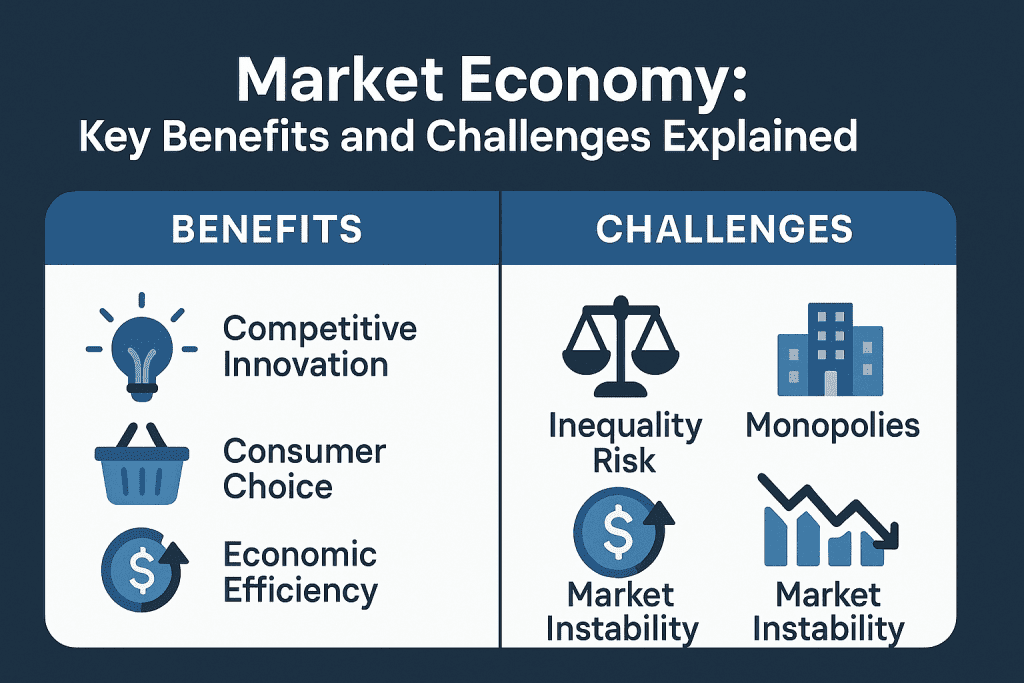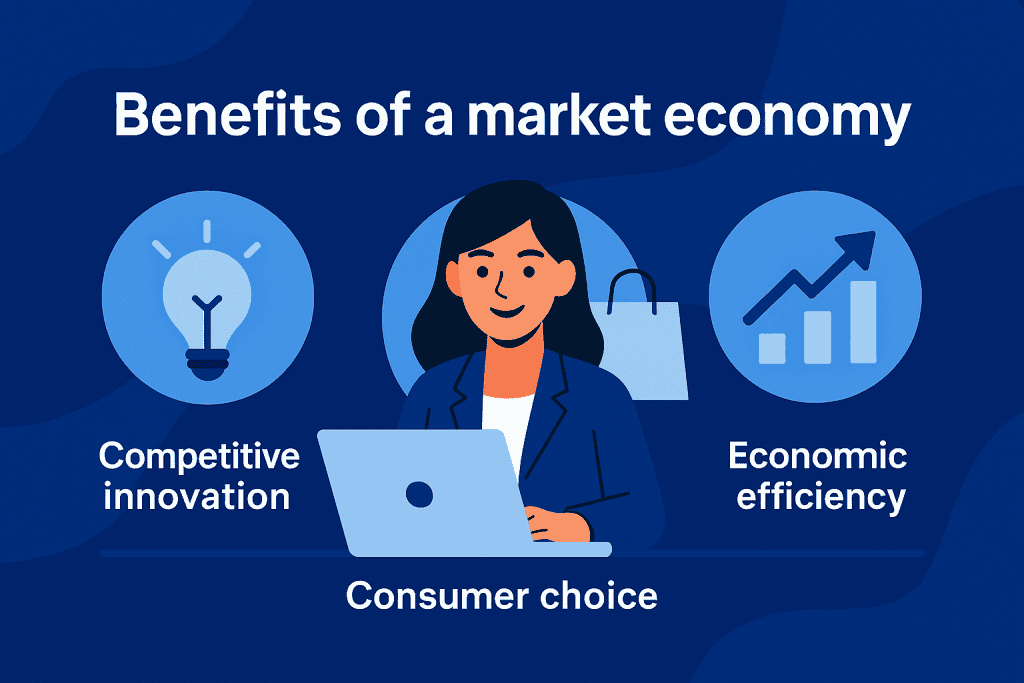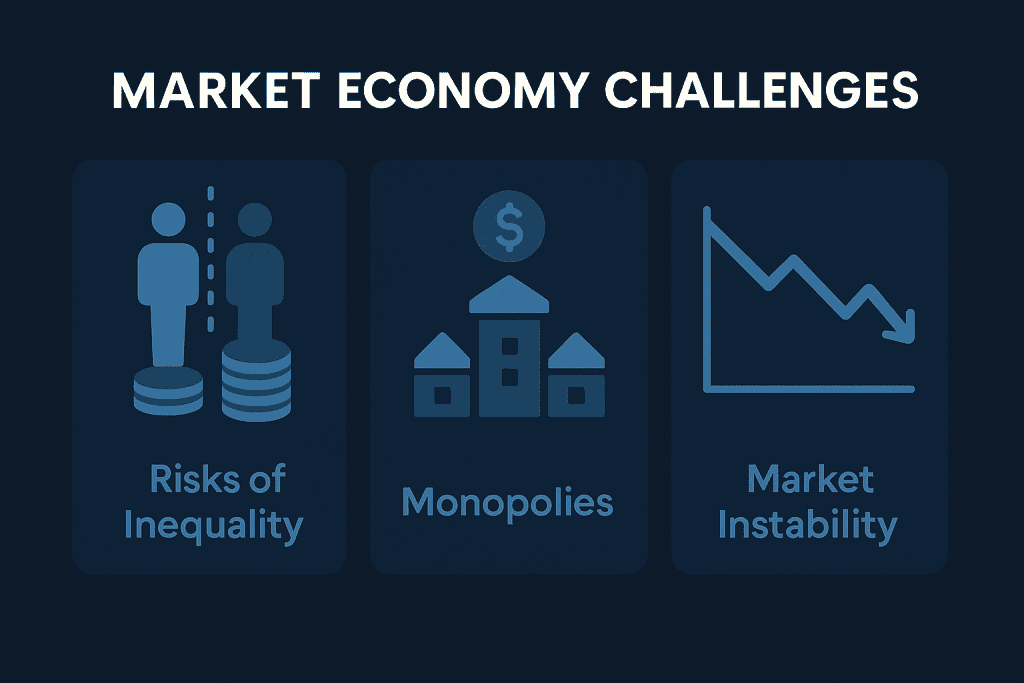
A market economy, where supply and demand primarily drive economic decisions, represents one of the most commonly practiced economic systems today. This system allows individuals and businesses to make their own choices with minimal government intervention, shaping everything from pricing to competition and product variety. In this review, we’ll explore the defining traits, advantages, and challenges of a market economy, alongside real-world applications and key insights from economic experts.
Overview of the Market Economy
A market economy is an economic system driven by the interactions of supply and demand, where private individuals and businesses make most decisions. In this kind of economy, governments generally limit interference, allowing individuals and companies to pursue their economic interests freely. This freedom encourages competition and entrepreneurship, fostering an environment where resources are allocated efficiently based on consumer demand.
This type of economy enables dynamic growth and innovation, as businesses work to attract customers and increase profits. Unlike command economies, where governments direct resources, market economies rely on the decentralized actions of numerous participants to guide production, pricing, and services. Common in capitalist nations, the market economy model empowers individuals to decide what to buy, produce, and sell, forming the backbone of many modern economies today.
Key Characteristics
- Consumer-Driven Demand: Buyers’ needs drive production, pushing companies to supply goods and services that people want.
- Competition-Based Pricing: Competition between businesses influences prices, encouraging quality improvements and innovation.
- Private Ownership: Individuals and businesses own and control resources, leading to a broad range of goods and services.
- Minimal Government Involvement: The government plays a limited role, generally only to regulate monopolies, protect property rights, and enforce contracts.
- Flexibility and Adaptability: Market economies adapt quickly to consumer preferences and technological advancements, maintaining relevance in rapidly changing landscapes.
Advantages of a Market Economy

Economic Efficiency
Market economies use resources effectively by aligning production with consumer demand. Companies prioritize profitability, which drives them to innovate and reduce waste. This efficiency translates to lower production costs and improved productivity, benefiting both consumers and businesses.
Encouragement of Innovation
Competition in a market economy incentivizes businesses to innovate continuously. Companies are motivated to introduce new products and improve existing offerings to attract consumers. As a result, this economy tends to see rapid technological advances and product diversification.
Wide Consumer Choice
Consumers in this economy enjoy varied choices in products and services. With numerous companies competing to attract customers, individuals benefit from diverse options at competitive prices, enhancing overall satisfaction and market inclusivity.
Income Opportunities
This economy fosters entrepreneurship by providing numerous opportunities for individuals to start businesses and pursue different career paths. This potential for income growth helps individuals improve their financial standing and boosts overall economic mobility.
Challenges and Limitations of a Market Economy

Income Inequality
Market economies often exhibit significant income inequality. In this system, wealth and resources tend to concentrate among those who own successful businesses or have high-demand skills. This disparity may hinder access to basic needs for lower-income individuals and communities.
Market Failures
Although market economies thrive on efficiency, they sometimes fail to address essential services like public goods. Since market-driven services focus on profit, areas such as healthcare, education, and environmental conservation may be underfunded, potentially leading to negative social outcomes.
Risk of Consumer Exploitation
With minimal regulatory oversight, large corporations may dominate specific markets, limiting choices and driving prices upward. Monopolies and price-setting strategies can lead to exploitation, disadvantaging consumers in the absence of competitive alternatives.
Environmental Impact
Profit incentives may encourage companies to prioritize growth over sustainability. Without sufficient regulation, businesses might disregard environmental considerations, leading to pollution, resource depletion, and other environmental issues, which have long-term effects on society.
Comparison: Market Economy vs. Command Economy
| Feature | Market Economy | Command Economy |
|---|---|---|
| Ownership | Predominantly private | State-owned |
| Decision-Making | Driven by individuals and businesses | Controlled by the government |
| Innovation | High due to competition | Limited, as innovation depends on state funding |
| Resource Allocation | Based on supply and demand | Centrally planned |
| Consumer Choice | Broad and varied | Limited |
In market economies, decisions are shaped by the market and individual actors, while command economies rely on central planning to guide economic outcomes.
Practical Applications and Real-World Examples
United States
The U.S. operates as a largely market-based economy where consumer demand drives production and service decisions. American companies compete in sectors like technology, finance, and healthcare, leading to a range of innovative products and services. Government intervention is minimal, mostly focused on regulations for fair competition and safety standards.
South Korea
South Korea combines this with selective government intervention. While it remains largely market-driven, the government has played a role in promoting growth in key industries like technology and automotive, balancing free-market operations with targeted support.
Germany
Germany operates a social market economy, which combines a competitive market with social welfare policies. While businesses have autonomy, government programs offer support for healthcare, education, and social welfare, aiming for a balance between economic growth and public welfare.
Singapore
Singapore showcases the flexibility of market-based economies with government intervention. Known for its business-friendly environment, Singapore attracts multinational companies by ensuring an open, competitive market with supportive policies.
Economic Perspectives: Evaluating Market Economies
Economists see market economies as flexible and responsive systems that encourage innovation and competition. However, many argue that without safeguards, these economies can contribute to income inequality and environmental harm. Experts advocate for a balance between regulation and freedom to ensure equitable opportunities and sustainability. As global challenges grow, some economists propose implementing social safety nets and sustainable practices to make market economies more resilient and inclusive.
Conclusion: The Sustainability of Market Economies
Market economies offer an adaptable and efficient approach to economic growth, empowering individuals and businesses through choice, competition, and innovation. However, challenges like inequality and environmental impact highlight the importance of regulatory frameworks. For long-term sustainability, governments and organizations must balance free-market practices with policies that support social welfare and environmental responsibility. As economies continue to evolve, the market model remains valuable but may require adjustment to meet future societal and ecological demands.
FAQ
What are the primary benefits of a market economy?
A market economy promotes innovation, efficient resource use, and broad consumer choice, driven by competition and minimal government control.
How does income inequality arise in a market economy?
Income inequality can develop because market economies reward high-demand skills and successful businesses, leading to wealth concentration.
Why is a market economy considered flexible?
A market economy adapts quickly to consumer preferences and technological advances, enabling growth and innovation through competition and supply-demand dynamics.
Resources
- Investopedia. What Are the Advantages of a Market Economy?
- Corporate Finance Institute. Market Economy Overview
- Ablison. Pros and Cons of Market Economy
- EduCBA. Advantages and Disadvantages of Market Economy
- This vs That. Command Economy vs Market Economy
